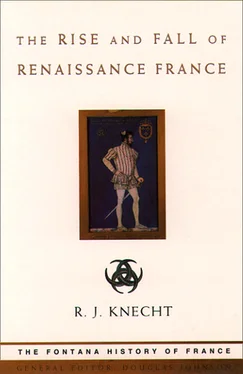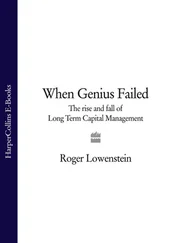The parlement took advantage of the king’s absence to launch an attack on religious dissenters. In February 1526 heresy was defined so broadly as to take in even the smallest deviation from religious orthodoxy. The censorship of books was tightened up, printers and booksellers being forbidden to publish or stock religious works in French. The parlement was particularly anxious to seize copies of Lefèvre d’Etaples’ Epitres et évangiles des cinquante et deux dimanches which had been published anonymously. However, books were not the only victims of the persecution. The juges délégués were asked to prosecute Lefèvre, Caroli, Mazurier and Roussel. This attack on the Cercle de Meaux prompted Francis’s only known intervention in the domestic affairs of his kingdom during his captivity. In November 1525 he ordered the parlement to suspend proceedings against Lefèvre, Caroli and Roussel, holding them to be innocent victims of persecution by the ‘Sorbonne’. But the parlement stuck to its guns: on 29 November the juges délégués were instructed by the court to press on with their activities regardless. Lefèvre and Caroli fled to Strassburg, while Mazurier recanted. As for Briçonnet, he decided to fall into line with orthodoxy. Another victim was Berquin, who was rearrested in January 1526, found guilty of heresy and sent to the parlement to be sentenced, but the court desisted when it learned that Francis was about to come home.
A serious bone of contention between the regent and the parlement was the Concordat. On 24 February 1525, Etienne Poncher, archbishop of Sens and abbot of Saint-Benoît-sur-Loire, died. In response to a request from Chancellor Duprat, who had recently taken holy orders, Louise appointed him to both benefices. However, both Sens and Saint-Benoît were exempt from the Concordat’s provisions and the chapters proceeded to elect their superiors: Jean de Salazar at Sens and François Poncher (Etienne’s nephew) at Saint-Benoît. Duprat promptly appealed to the papacy which quashed the elections; the chapters appealed to the parlement. A protracted legal struggle ensued which was inflamed when Duprat sent an armed force to occupy Saint-Benoît, and the parlement tried to dislodge it. The regent evoked both lawsuits to the Grand conseil which consequently found itself in dispute with the parlement. On 24 June the two courts were ordered to hand over the lawsuits to a special commission appointed by Louise. At the same time she sent troops to Paris, presumably to force the parlement’s compliance.
The quarrel was given a dangerous new twist in July, when the parlement mounted an attack on Duprat, whom it had never forgiven for his part in securing the Concordat. He was summoned to Paris to answer certain charges, but the regent would not let him go. She asked for an explanation of the parlement’s conduct and kept its representatives waiting several weeks before granting them an audience. Her procrastination paid off. The parlement dropped its attack on the chancellor and agreed not to judge the affairs of Sens and Saint-Benoît if the Grand conseil would do likewise. This satisfied Louise, who allowed matters to rest there until her son’s return.
The Treaty of Madrid (January 1526)
Foreign policy was the most successful aspect of Louise of Savoy’s regency. While negotiating with Charles V for her son’s freedom, she worked to break up the Anglo-imperial alliance and stirred up trouble for the emperor in Italy and elsewhere. His terms for the release of Francis were anything but generous. The king was to give up Burgundy and all other territories owned by Charles the Bold in 1477; also Thérouanne and Hesdin. Bourbon’s property was to be restored; an independent kingdom, including Provence, was to be created for him; and his accomplices were to be pardoned. Henry VIII’s French claims were to be satisfied and Francis was to settle an indemnity owed by the emperor to Henry. The prince of Orange, whom the French had taken prisoner, was to be released and his principality restored. Peace was to be sealed by a marriage between Charles’s niece Mary and the Dauphin. Finally, the king’s release was to be conditional on the peace treaty being ratified by the French estates and parlements.
When these terms were laid before Francis in April 1525, he refused to discuss them, and referred the imperial envoy Beaurain to Louise. She appointed François de Tournon, archbishop of Embrun, as ambassador. His instructions stated that no part of France was to be ceded to the emperor. Tournon was soon joined in Spain by Jean de Selve. Both men saw Charles V in Toledo on 17 July, when he refused ever to accept a ransom for Francis. Burgundy was the main stumbling-block in the negotiations. On 16 August, Francis made a secret declaration to the effect that he would never cede the duchy of his own free will, and that if he were compelled to do so his action would be null and void.
Louise, meanwhile, set about destroying the Anglo-imperial alliance. The English government, fearing a separate peace between Francis and Charles, resumed secret negotiations with the regent which Pavia had interrupted. On 30 August the Treaty of the More was signed, restoring peace between England and France and drawing them together in a defensive alliance. Henry VIII undertook to use his influence with Charles to obtain Francis’s release. Francis, for his part, promised to pay Henry two million écus in annual instalments of 100,000 écus. Maritime disputes between the two countries were to be settled. The Scots were to stop armed raids across the border and Albany was banned from Scotland during James V’s minority. France agreed to indemnify Louis XII’s widow Mary, now duchess of Suffolk, for losses she had incurred during the war. Because Francis was not free to ratify the treaty, the English demanded special guarantees in the form of registration by four parlements and two provincial estates as well as financial pledges from nine major towns, including Paris, and eight noblemen. Louise asked the parties concerned to signify their acceptance of these terms, but they viewed them as a serious breach of their privileges. The Parlement of Paris waited till 28 October before ratifying the treaty and the estates of Normandy never did so. The eight noblemen complied with the regent’s request, but the towns, especially Paris, proved troublesome. Fortunately for Louise, she was able to persuade the English government to postpone the deadline for the surrender of the pledges.
In June 1525, Louise offered the pope and Venice an alliance aimed at driving the imperialists out of Italy and forcing Charles to release her son. It was not concluded, however, because Louise was only willing to give financial help to her allies: she was afraid of alienating the emperor permanently by offering them military aid. Her diplomacy also encompassed the eastern Mediterranean. John Frangipani was dispatched to the sultan with an appeal for aid from Francis and his mother. Suleiman promised in reply to lead an expedition against the emperor.
On 11 September, Francis fell gravely ill and the emperor, who so far had avoided seeing him, hastened to his bedside. The two rivals embraced and exchanged friendly greetings. Next day Marguerite arrived, after travelling post-haste from France. On 22 September, Francis lapsed into a semi-coma, but a ‘miracle’ suddenly occurred: an abscess inside the king’s head burst, his fever dropped and his spirits revived. His companions were soon able to inform the regent and the parlement that he was out of danger.
Marguerite now went to Toledo to negotiate her brother’s release; but the imperial council held out no hope of concessions. Francis declared that he would rather remain a prisoner for good than dismember his kingdom. In November he abdicated in favour of his seven-year-old son, the Dauphin François, but the deed of abdication was not sent to the parlement for registration. It was almost certainly nothing more than a ploy aimed at frightening Charles into making concessions. In November, after Marguerite had decided to go home, Louise instructed her envoys to make peace at any price. ‘What was the point of losing a kingdom’, she asked, ‘for the sake of a duchy?’ Francis apparently came round to this view: he accepted the emperor’s terms on condition that his release preceded the surrender of Burgundy; as he explained, he alone could persuade his subjects to give up the duchy. Going against Gattinara’s advice, Charles agreed to this condition in return for guarantees: Francis had to swear on the Gospels and give his word as a nobleman that he would hand over the Dauphin and his brother as hostages and would return to prison in the event of the treaty not being fulfilled. Charles needed peace, for he was in dire financial straits. He also knew that a new coalition, including England, Venice and the papacy, was being formed against him. The German situation remained bleak and, further east, the Turks were preparing the offensive which was to destroy the Hungarian monarchy on the field of Mohácz.
Читать дальше












